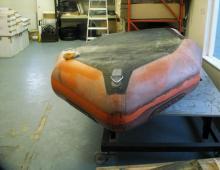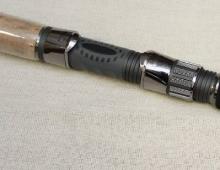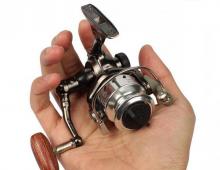Best Inexpensive Feeder Rods
Feeder fishing is considered one of the most common ways of fishing. And very often fishermen manage to get a worthy trophy only thanks to her. Yes, and the tackle is quite simple in structure, and requires only minimal knowledge of the fishing conditions from the fisherman, namely the depth and speed of the current. Having such data, you can easily choose the right feeder rods. They are the key in the structure of gear, so today we will talk about them.
- - a great catch is guaranteed!
When choosing a feeder rod, you need to know some basic requirements for their models and materials. And following the recommendations for choosing a blank feeder rod model, you can find the right one for you. And the optimal choice of model, its advantages and the final answer to the question of which feeder rod to buy can only be indicated by practical application.
For example, if you are going to fish with long casts, then a long rod blank with a large test will be better for you. If you plan to catch small fish in a small pond, then it is better to choose a lighter type of rod. Yes, and if you often catch in this way, you will feel when the moment comes, indicating to you the urgent need to purchase a professional feeder. The characteristic of the rod is affected by its test, length and material.
Today, the most common are feeder rods with a length of 2.7 to 4.8 meters. Most often, the step between the length is 30 centimeters, but there are English feeders that have their own length scale. I use long rods, about 3.8-4 meters. This length is attractive for fishing at long distances, as it allows you to easily deliver the equipment to the required distance.
In addition to the ability to cast far, feeder rods give the angler complete control over the equipment. This is especially true when fishing in a large current, but you will have to choose a rod length of about 4.5-4.8 meters. Before you buy a feeder rod for fishing in such conditions, you need to know that it must stand on the bank in an upright position. This is done in order to shorten the length of the fishing line in the water.

In expensive branded rods, there is one feature that helps anglers a lot - this is an additional knee, due to which you can quickly increase the length of the blank right on a fishing trip. Based on this, we can assume that by buying it a rod you immediately guarantee yourself a blank for various fishing conditions. It is difficult to call it universal, but there is something of this kind.
A very important point that you need to pay attention to during the purchase is the feeder rod test, a little lower we will take a closer look at this issue. Briefly about what the text is - this is the maximum weight of tackle that will not harm the feeder rod during casting. Often it is applied to the rod itself and two values \u200b\u200bare indicated, from and to, that is, the minimum and maximum value. But very rarely there are forms with one number - this is the maximum test.
Having studied all these parameters, you can buy a good and inexpensive feeder rod. On cheap feeders, you can see an underestimated test, under this condition, you can safely put tackle a couple of tens of grams heavier. expensive rod models are calibrated more carefully and the test is indicated there accurately. My advice to you is to use tackle for long-distance casting a little less than the test of the judge, by about 10-25 grams. At short distances, you can put it heavier.

Excellent rods that have appeared on the domestic fishing market relatively recently. And they immediately began to win the hearts of anglers with their price and quality. Feeder rods Zemex Pro cost from 50 to 200 dollars, which allows the angler, depending on his income, to choose a rod for himself. I recently purchased a ZEMEX Pro Feeder 12ft 150g fast and am very happy with it.

Excellent rods, which the manufacturers have given a fairly good value for money. The reviews of anglers on the net speak for themselves, the vast majority simply praise Mikado feeder rods, saying that they did not expect to get great quality for such a low price. The most popular model is the Mikado Ultraviolet Light Feeder.
Feeder rods from the manufacturer Salmo are famous for their reliability, like all products of the manufacturer. Yes, and they are relatively inexpensive, the price of rods ranges from 50 to 200 dollars. There are just a huge number of reviews about these rods on the net, and after studying them, I realized that the negative reviews are written by anglers who do not know how to catch or store rods. Basically, the blow goes to the fact that they break. Well, everyone understands that if you carry a form in the trunk and wave it along the branches, then it will not stand it. So, I think you yourself understand that Salmo simply cannot sacrifice his reputation by releasing bad products.

Feeder fish are famous among anglers for their huge price and high quality. Of course, the high cost can be attributed to the disadvantages, but the quality to the pluses. I've been using a Shimano Joy Feeder 360 rod for many years, which costs about $50 and performs great on fishing. So I advise you.
Today there are a lot of manufacturers of feeder rods, but only a few of them are in the lead in the fishing market. The key to this is reliability, and this is achieved only with the help of quality materials and the use of modern production technologies. Feeder rods from the following manufacturers are considered the best:
- First on our list are forms from the manufacturer Mikado. A wide range of anglers prefer these rods due to their low price and high quality. Anglers single out the best rods with a length of 3.5 meters. Long rods from manufacturers are somewhat worse. They are too heavy and insensitive, which drastically reduces the success of fishing;
- The following are the legendary Japanese rods from Shimano. The wide range of the Japanese manufacturer simply makes the eyes run wide. But in order to buy such a rod, you need to at least belong to the middle class of residents. The main material for the production of rods is carbon fiber. Recently, the guys decided to conduct a series of experiments, making rods from an unusual material - geofiber. Geofiber rods have excellent qualities such as high sensitivity, strength and flexibility. And thanks to their low weight, they are conveniently located in the hand of the angler;
- Our friends from the Baltic States, who head the Salmo company, decided to please anglers with a low budget with inexpensive feeder rods of good quality. But the company does not have its own production facilities and they simply buy components from other manufacturers, and then they only assemble everything together and the output is pretty good sticks;
- Banax Picolo feeder rods, which, according to the manufacturers, were designed specifically for fishing in our conditions. A feature of these rods is that absolutely every model is equipped with an additional tip with which you can easily increase its length by half a meter. The list of materials used in the production of such rods includes graphite, which is very light and at the same time strong;
- And the final ones in our rating of inexpensive feeder rods are feeders from the Japanese manufacturer Daiva. Manufacturers delight anglers with a wide range of light and heavy professional rods. Daiwa feeders are famous among fishermen for their durability and reliability.

Now, after we have identified the best inexpensive feeder rods, do not forget about the coasters for them. After all, constantly holding them in your hand is first of all uncomfortable, and they must always be in an elevated state, and under certain fishing conditions, even in an upright position. For fishing with one rod, a simple slingshot-shaped stand will suffice. And if you are fishing with several tackles at the same time, then it is better to buy a special multi-section stand.
Feeder fishing makes anglers happy and allows them to experience all the delights of fishing. But this is possible only with the right choice of feeder rod, because if it is chosen incorrectly, the fishing will go bad. Therefore, it is worth knowing in advance about the conditions of fishing, well, follow some tips, which we will discuss below.
Before you go to the store, you need to know how to choose the right feeder rod. And in order to deal with this, you need to answer yourself a few very important, but at the same time simple questions:
- Have you ever fished with a feeder rod before? If you do not have experience in this type of fishing, then there is no special need for careful selection of gear. Up to a certain point, you will not be able to notice the differences between this or that rod, as well as its advantages. It is best to get precious experience with the most versatile rod. Otherwise, you will constantly break tackle and you will not be able to get positive emotions. You yourself will notice that the moment has come when you need to choose a feeder for yourself and according to what requirements to do it.
- The next question should be asked immediately after the first, and this question is: how far are you going to throw the tackle?
- And it is also necessary to deal with the speed of the current in the reservoir, answer immediately if it is there?
- What size fish do you like to catch? With the help of questions 2-4, you can finally decide on the choice of test and rod length. Which will greatly simplify the lining of the best gear.
- How often do you go fishing? If you plan to go fishing only a couple of times a year, then buying a rod that is too expensive is pointless. If you are going to go fishing quite often, then you should pay attention to more expensive and high-quality models of professional feeder rods.

The characteristic of a fishing rod for a feeder depends on three main parameters. The first and most important parameter is the test, which shows the weight range of the rig. An equally important characteristic is the length, on which the casting distance depends. And the third characteristic is the material from which the rod is made, it affects the weight and strength of your equipment.
A rod with different values of these parameters is selected depending on the fishing conditions and based on the answers to the above questions. Always consider everything so that your rod is clearly suited to the conditions of fishing. The more it matches them, the better the fishing will be.
The feeder rod test is its main characteristic; with its help, the angler can find out what weight of lures to count on. Each rod is designed for fishing in specific conditions. And in order to use the full potential of the rod, you need to choose its test in accordance with the rig used. Mandatory, on each rod is indicated the range or one specific value (maximum) of the allowable weight of the equipment used. Depending on the test, the rods are classified as follows:
- Light, also known as "light" (L), are allowed to be fished with tackle no heavier than 30 grams;
- Medium-light, the so-called "medium-light" (ML), you can catch them with tackle weighing up to 60 grams;
- Medium feeder rods, or "medium" (M), allow you to catch tackle up to 80 grams;
- Medium-heavy feeders, or “medium-heavy” (MH), are designed for fishing with gear weighing no more than 100 grams;
- Heavy rods, or "heavy" (H), allow you to fish with tackle with a feeder weight of up to 120 grams;
- Super-heavy feeders, or "extra-heavy" (EH), there is no upper limit on the mass of the equipment, the lower one is 120 grams.

Moreover, the need to comply with the test is very large. If you take tackle of less weight than indicated on the rod, then its sensitivity will decrease significantly. Well, if you take tackle heavier than the specified test, then you can simply break the rod during the cast.
The action of a feeder rod is a characteristic that is responsible for the stiffness of the whip (tip). Speaking in plain language, the system is the parameter on which the shape of the bend of your rod depends during the cast. Build fishing rods are divided into:
- Fast, or "fast";
- Slow, or "slow";
- Medium, or "medium", is very rare, but there is another name - "moderate".

It is extremely rare to find rods with a “medium-fast” action, if translated, it will turn out to be something like a medium-fast action. The build can be determined by looking at the shape of the bend, well, for this you need to have some skills. Many anglers, and myself, have repeatedly noticed that the stronger the current on the pond, the more flexibility the rod should have. Well, for fishing in stagnant ponds, rods of slow and medium action are well suited.



